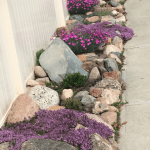Rock gardens are a popular and timeless landscaping feature that add a unique, natural element to any outdoor space. The appeal of rock gardens lies in their low maintenance, practical benefits, and aesthetic charm. This article aims to explore various aspects of rock gardens, from the different types of rocks to use and design ideas to choosing suitable plants and tips for maintenance.
One of the key advantages of rock gardens is their ability to thrive in challenging environments such as dry or rocky terrain. They offer an opportunity to create visually striking landscapes that require minimal upkeep. With the right selection of rocks and plants, a rock garden can become a beautiful focal point in any garden or yard.
Whether you’re considering adding a rock garden to your property or simply seeking inspiration for your existing one, this article provides valuable insights into the world of rock gardens. From DIY projects to expert tips on design and layout, there’s something here for every aspiring rock gardener.
Benefits of Rock Gardens
Rock gardens offer a range of practical and aesthetic benefits that make them a popular choice for landscaping. From adding visual interest to requiring minimal maintenance, rock gardens are versatile and can be tailored to suit different spaces and preferences.
One of the primary advantages of rock gardens is their low maintenance requirements. Unlike traditional flower beds, rock gardens typically require less water and upkeep, making them an ideal option for those with busy schedules or minimal gardening experience. In addition, the use of rocks in garden design can help prevent soil erosion and reduce the need for frequent weeding, saving time and effort in the long run.
In terms of aesthetics, rock gardens can add texture, depth, and dimension to a landscape. The varying shapes, colors, and sizes of rocks can create visual interest and serve as a focal point in outdoor spaces. By carefully selecting and arranging rocks within a garden, it is possible to achieve a natural look that complements the surrounding environment.
When it comes to choosing rocks for a garden, there are several options available depending on the desired aesthetic and budget. Common types of rocks used in rock gardens include river rocks, flagstone, lava rocks, granite, quartzite, and shale. Each type has its own unique characteristics such as color variation and texture, allowing for creativity in designing a visually appealing rock garden.
| Advantages | Description |
|---|---|
| Low Maintenance | Rock gardens typically require less water and upkeep compared to traditional flower beds. |
| Aesthetics | Rock gardens add texture, depth, and dimension to a landscape. |
| Rock Types | River rocks, flagstone,lava rocks etc. can all be used in rock gardens. |
Types of Rocks to Use
When creating a rock garden, the choice of rocks plays a crucial role in determining the overall look and feel of the landscape. There are various types of rocks that can be used to construct a rock garden, each with its unique characteristics and aesthetic appeal.
Sedimentary Rocks
Sedimentary rocks such as sandstone, limestone, and shale are popular choices for rock gardens due to their color variations and ease of shaping. Sandstone, with its warm hues and natural texture, adds a rustic charm to the garden, while limestone offers a more formal and structured appearance. Shale, on the other hand, provides a layered look that creates visual interest.
Igneous Rocks
Igneous rocks like granite and basalt are prized for their durability and striking appearance. Granite, with its speckled pattern and variety of colors, adds a bold statement to the rock garden, while basalt’s dark tones and fine texture create a sense of sophistication.
Metamorphic Rocks
Metamorphic rocks such as marble and quartzite bring elegance and refinement to rock gardens. Marble’s luxurious veining and smooth surface make it an exquisite choice for creating focal points or accentuating specific areas in the garden. Quartzite’s vibrant hues and distinctive patterns add drama to the landscape.
Each type of rock brings its own unique characteristics to a rock garden, offering endless possibilities for creating visually stunning landscapes that reflect personal style preferences. Experimenting with different combinations of rocks can result in captivating arrangements that capture the essence of natural beauty within a rock garden design.
Design and Layout Ideas
Naturalistic Arrangement
One of the most popular ideas for rock gardens is creating a naturalistic arrangement that mimics the look of a natural rocky landscape. This can be achieved by strategically placing larger rocks to resemble boulders and smaller rocks to simulate a rocky terrain. By incorporating varying sizes and shapes of rocks, you can create depth and dimension in your rock garden, giving it an authentic and organic feel.
Terracing
Terracing is another effective design idea for rock gardens, especially in areas with sloping terrain. By creating terraced levels using rocks, you can not only prevent soil erosion but also add visual interest to your garden. Terracing allows for the cultivation of different plant species on each level, further enhancing the diversity and beauty of your rock garden.
Focal Point Features
Introducing focal point features in your rock garden can elevate its overall aesthetic appeal. Consider adding a cascading water feature, a miniature rock bridge, or a sculptural rock formation as a focal point to draw attention and create visual interest. Incorporating unique and eye-catching elements will make your rock garden stand out as a captivating outdoor space.
By considering these design and layout ideas, you can transform your outdoor area into a stunning rock garden that showcases the beauty of nature while providing tranquility and serenity. Whether you opt for a naturalistic arrangement, terracing, or introduce focal point features, there are endless possibilities to express creativity and individuality in creating your ideal rock garden.
Choosing Plants for Rock Gardens
When it comes to choosing plants for your rock garden, it’s important to select options that are not only visually appealing but also easy to maintain. Low-maintenance and drought-resistant plants are ideal for rock gardens as they require minimal attention and can thrive in rocky, arid conditions. Some popular plant options for rock gardens include sedum, yarrow, lavender, and thyme. These plants are known for their resilience and ability to flourish in rocky terrain.
Sedum is a versatile succulent that comes in a variety of colors and shapes, making it a great choice for adding visual interest to your rock garden. Yarrow is valued for its feathery foliage and clusters of vibrant flowers, while lavender brings both beauty and fragrance to the garden.
Thyme is another excellent option, known for its low-growing habit and aromatic foliage. These plants not only add texture and color to the rock garden but also require minimal water once established.
In addition to selecting low-maintenance and drought-resistant plants, it’s important to consider the overall aesthetic you want to achieve with your rock garden. Mixing different plant heights, textures, and colors can create a visually appealing and dynamic landscape. Consider incorporating ground covers like creeping phlox or ice plant to fill in bare spaces between rocks, adding another layer of visual interest to your rock garden design.
| Plant Options | Description |
|---|---|
| Sedum | Versatile succulent available in various colors and shapes |
| Yarrow | Valued for feathery foliage and clusters of vibrant flowers |
| Lavender | Adds beauty and fragrance to the garden |
| Thyme | Low-growing with aromatic foliage; requires minimal water once established |
Remember that certain plants thrive in specific regions due to climate conditions so be sure to research which low-maintenance plants are suitable for your local area before finalizing your choices. With careful selection of plant options tailored towards the unique needs of a rock garden, you can create a beautiful and sustainable landscape with minimal effort required in maintenance.
Maintenance Tips
Once your rock garden is established, it’s important to maintain it properly to keep it looking its best. Here are some valuable maintenance tips to help you care for your rock garden:
Maintenance Tips for Rock Gardens:
1. Weed Regularly: Keep your rock garden free from weeds by regularly inspecting and removing any unwanted growth. This will help maintain the neat and tidy appearance of your rock garden.
2. Water Wisely: When watering your rock garden, be mindful of the specific water needs of the plants in your garden. Overwatering can lead to issues such as root rot, so it’s essential to water wisely and according to the individual requirements of each plant.
3. Prune and Trim: Keep your rock garden looking well-groomed by routinely pruning and trimming any overgrown or unruly plants. This will not only enhance the overall aesthetic but also promote healthy growth.
4. Monitor for Pests and Diseases: Regularly inspect your rock garden for signs of pests or diseases that could potentially harm your plants. Taking prompt action against any issues will help maintain the health and vitality of your rock garden.
By following these maintenance tips, you can ensure that your rock garden remains a beautiful and thriving addition to your outdoor space for years to come.
Remember, a well-maintained rock garden not only adds visual interest to your landscape but also provides a low-maintenance gardening option that can thrive in various conditions with minimal effort on your part.
Rock Garden Inspiration
Rock gardens have gained popularity for their ability to add visual interest and create a unique focal point in any landscaping design. Whether it’s a small corner of the yard or a large area, rock gardens can be tailored to fit any space. To spark creativity and provide inspiration, here are some stunning examples of rock gardens that showcase the versatility and beauty of this landscaping feature:
Examples of Rock Gardens:
- Zen-Inspired Rock Garden: A minimalist and serene rock garden that uses carefully arranged rocks, gravel, and a few select plants to create a peaceful and calming space. This type of rock garden is perfect for meditation or contemplation areas.
- Alpine Rock Garden: Mimicking the rugged terrain of high mountain regions, an alpine rock garden features small, low-growing plants and rough-looking rocks to create a naturalistic landscape. This type of rock garden is ideal for adding interest to sloped or uneven terrains.
- Desert-Themed Rock Garden: Incorporating cacti, succulents, and drought-tolerant plants, this rock garden design captures the essence of arid desert landscapes. Utilizing sand or gravel as ground cover and placing large boulders strategically, this type of rock garden creates an eye-catching display while requiring minimal maintenance.
These examples illustrate just a few possibilities for creating visually captivating rock gardens. Each design can be adapted to suit individual preferences and the specific characteristics of the outdoor space. By drawing inspiration from these ideas, homeowners can envision how they might incorporate elements into their own unique rock garden designs.
Whether aiming for a tranquil retreat or an eye-catching display, there are endless ideas for rock gardens that can be tailored to fit various styles and preferences. From incorporating water features to utilizing rocks with different textures and colors, the options are limitless when it comes to creating a visually appealing and functional outdoor space.
DIY Rock Garden Projects
In conclusion, rock gardens are a fantastic addition to any outdoor space, offering both practical and aesthetic benefits. By incorporating different types of rocks and carefully selecting low-maintenance plants, homeowners can create a beautiful and sustainable landscape feature. With the right design and layout ideas, a rock garden can become a stunning focal point in any garden or yard.
When it comes to creating a rock garden on a budget, there are numerous DIY projects that can help homeowners achieve their desired look without breaking the bank. From building rock walls to creating pathways and arranging rocks in an artistic manner, there are plenty of affordable options for those looking to add a touch of natural beauty to their outdoor space.
Whether you’re starting from scratch or giving your existing garden a makeover, these DIY projects offer endless possibilities for creating a personalized rock garden that suits your unique style.
For those seeking inspiration and guidance on how to get started with their own rock garden project, there are countless resources available online and in gardening books. By exploring different types of rocks, considering layout options, choosing suitable plants, and learning about maintenance tips, anyone can bring their ideas for rock gardens to life. With careful planning and execution, the result will be an eye-catching and sustainable feature that enhances the natural beauty of any outdoor space.

Welcome to my gardening blog! I am passionate about plants and enjoy sharing my knowledge and experiences with others. In this blog, I will write about everything related to gardening, from tips on how to get started to updates on my own garden projects.





